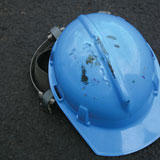Since its initial publication in 1995, ASTM International's material standard for polyisocyanurate insulation, ASTM C1289, "Standard Specification for Faced Rigid Cellular Polyisocyanurate Thermal Insulation Board," has undergone a number of changes and improvements. However, at this point, NRCA recommends incorporating additional improvements into that standard to make it more functional for polyisocyanurate insulation users.
Background
ASTM C1289 was developed during the early 1990s, largely as a compilation of two existing standards: ASTM C1013, "Standard Specification for Faced Rigid Cellular Polyisocyanurate Roof Insulation," and ASTM C984, "Standard Specification for Perlite Board and Rigid Cellular Polyisocyanurate Composite Roof Insulation." Once ASTM C1289 was published, ASTM International subsequently withdrew ASTM C1013 and ASTM C984.
While ASTM C1289 was being developed, the task group responsible for the standard acknowledged some additional developments and refinements would be necessary after the standard's initial publication. For example, in response to a negative vote I had submitted on the standard's final draft ballot, the task group and Polyisocyanurate Insulation Manufacturers Association (PIMA) committed to developing and incorporating into the standard a methodology for addressing polyisocyanurate insulation's resistances to facer sheet delaminations.
Since its initial publication, ASTM C1289 has undergone several noteworthy revisions. In 2001, "Grade" classifications were added to differentiate increased levels of compressive strength for polyisocyanurate insulation. Also, in 2002, the long-term thermal-resistance method for testing and reporting R-value was added.
Recommended revisions
Although improvements have been made, significant additional changes to ASTM C1289 still are necessary.
A methodology for properly addressing polyisocyanurate insulation's resistances to facer sheet delamination has yet to be incorporated into ASTM C1289. An ASTM International task group is attempting to develop a test method based on the "rolling load emulator" for quantifying and reporting polyisocyanurate insulation's resistance to facer sheet delamination. To date, progress on this test method has been slow.
Also, ASTM C1289 needs to more accurately differentiate between the various facer sheet types commonly used in roof systems. Currently, ASTM C1289, Type I (Class 1 and Class 2) designates aluminum foil facers; ASTM C1289, Type II, Class 1 designates "glass fiber reinforced cellulosic felt or uncoated or coated polymer-bonded glass fiber mat" facers; and ASTM C1289, Type II, Class 2 designates "coated polymer-bonded glass mat" facers.
When ASTM C1289 was developed, the Class 1 designations were intended to address roofing products, and the Class 2 designations were intended to address wall sheathing products. Currently, it appears most manufacturers' polyisocyanurate roof insulation complies with ASTM C1289, Type II, Class 1.
NRCA's concern with the ASTM C1289, Type II, Class 1, designation is that its facer sheet description is too broad and nondescript and does not address the various roof system types and application methods. For example, ASTM C1289 does not indicate whether a facer sheet is perforated or otherwise vapor-permeable, making the polyisocyanurate insulation product suitable for hot bitumen applications. Similarly, the standard does not indicate whether facer sheets are relatively nonporous, making them appropriate for cold-adhesive applications.
What is needed are narrower-focused, more specific facer sheet descriptions within the standard. Two years ago, PIMA committed to addressing this issue and has yet to follow through.
Closing thoughts
Although ASTM C1289 has been in place for 10 years, additional improvements to the standard are necessary.
I ask polyisocyanurate insulation manufacturers and PIMA to follow through on their previous commitments and work constructively within ASTM International to address these issues expeditiously.
Until then, specifiers should work closely with roofing material manufacturers and polyisocyanurate insulation manufacturers and select polyisocyanurate insulation products that have facer sheets appropriate for the roof system type and application method used.
Mark S. Graham is NRCA's associate executive director of technical services.

